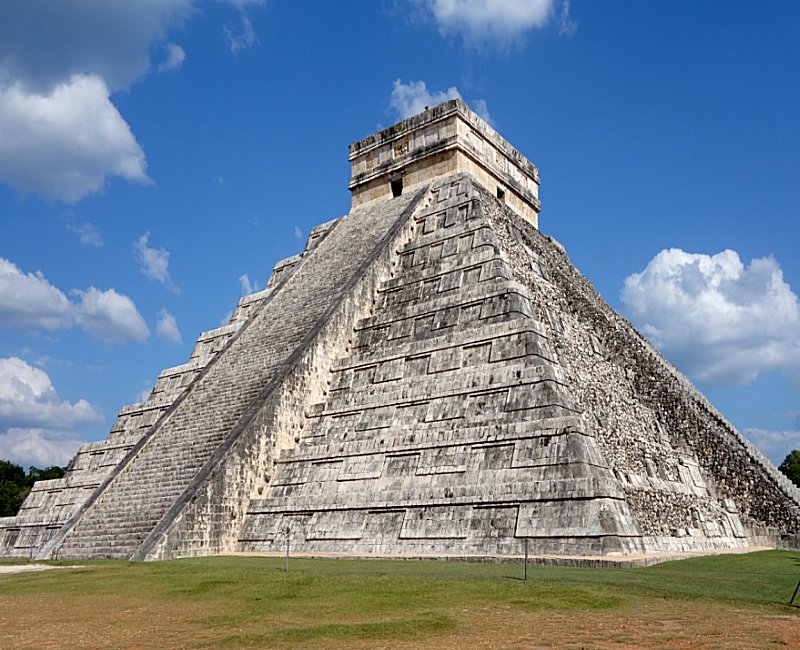Kukulkan (Quetzalcoatl): Feathered Serpent And Mighty Snake God
A. Sutherland - AncientPages.com - Known under several different names, Kukulkan (also Kukulcan), the Feathered Serpent, was one of the most important gods in Mesoamerica.
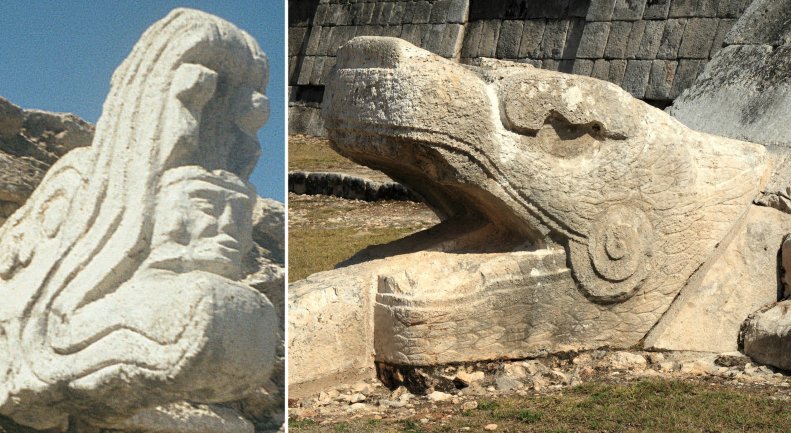 Left: Ballcourt marker from the Postclassic site of Mixco Viejo in Guatemala. This sculpture depicts Kukulkan, jaws agape, with the head of a human warrior emerging from his maw. Iamge credit: Simon Burchell - CC BY-SA 3.0; Right: Kukulkan at the base of the west face of the northern stairway of El Castillo, Chichen Itza. Image credit: Frank Kovalchek - CC BY 2.0
Left: Ballcourt marker from the Postclassic site of Mixco Viejo in Guatemala. This sculpture depicts Kukulkan, jaws agape, with the head of a human warrior emerging from his maw. Iamge credit: Simon Burchell - CC BY-SA 3.0; Right: Kukulkan at the base of the west face of the northern stairway of El Castillo, Chichen Itza. Image credit: Frank Kovalchek - CC BY 2.0
The Aztecs called him Quetzalcoatl, and the ancient Maya called him Kukulkan. The K'iche' group of Maya named him Gukumatz.
Was this mighty snake deity a genuine historical person?
It is not easy to trace the ancient history of Kukulkan. Like all of the feathered serpent gods in Mesoamerican cultures, Kukulkan is thought to have originated in Olmec mythology, and we still know very little about the mysterious Olmec civilization.
The true identity of the god Kukulkan becomes an even more significant problem due to the confusing references to a man who bore the name of the Mayan god. Because of this, the distinction between the two has become blurred.
Westside of the Temple of Kukulcan. Image credit: Luka Peternel - CC BY-SA 4.0
Around the 10th century, a priest or ruler appeared in Chichen Itza. This sacred site was one of the most potent Mayan centers of the Yucatán peninsula, Mexico, where we find El Castillo, also known as the Temple of Kukulkan.
Depicted as a serpent with feathers, Kukulkan showed up on many Mayan temples. This god later on became adopted by the Aztecs and Toltec people, and his name changed to Quetzalcoatl.
El Castillo square in plan and reaching 30 meters in height dominates the Main Plaza, and is the spectular structure at Chichen Itza. The temple was dedicated to the Feathered Serpent, Quetzalcoatl (known locally as Kukulkan). This deity is of Central Mexican origin and assumed a preeminent position in the pantheons of Teotihuacan and Toltec Tula.
Attesting to this dedication, low stone railings flanking the principal staircase on the northeastern side, those facing the Venus Platform, terminate in carved heads of Feathered Serpents.
Kukulkan originated among the Maya of the Classic Period (200 AD to 1000) when he was known as Waxaklahun Ubah Kan, the War Serpent. Maya writers of the 16th century describe Kukulkan as a historical person. Still, the earlier 9th-century texts at Chichen Itza never identified him as human, and artistic representations depicted him as a Vision Serpent entwined around the figures of nobles.
According to ancient Maya beliefs, Kukulkan - popularly known as the Feathered Serpent - was the god of the wind, sky, and the Sun. In Aztec culture and literature, he was a supreme leader of the gods, depicted just like Quetzalcoatl, whose name originates from the Nahuatl language and means "Precious serpent" or "Quetzal-feathered Serpent." Kukulkan gave humanity his learning and laws. He was merciful and kind but could also change his nature and inflict great punishment and suffering on humans.
According to Maya legend, the Maya were visited by a robed Caucasian man with blond hair, blue eyes, and a beard, who taught the Maya about agriculture, medicine, mathematics, and astronomy. This being was Kukulkan – the Feathered Serpent.
Kukulcan warned the Maya of another bearded white man who would not only conquer the indigenous people of Central America but would also enforce a new religion upon them before he was to return. Despite the warning, the Maya mistakenly welcomed the invading Cortes as Quetzalcoatl.
The cult of Kukulkan spread as far as the Guatemalan Highlands, where Postclassic feathered serpent sculptures are found with open mouths from which protrude the heads of human warriors.
Hundreds of North and South American Indian and South Pacific legends tell of a white-skinned, bearded lord who traveled among the many tribes to bring peace about 2,000 years ago. This spiritual hero was best known as Quetzalcoatl.
Some of his many other names were:
Kate-Zahl (Toltec)
Kul-kul-kan (Maya)
Tah-co-mah (NW America)
Waicomak (Dakota)
Wakea (Cheyenne, Hawaiian, and Polynesian)
Waikano (Orinoco)
Hurakan, the Mighty Mexico,
E-See-Co-Wah (Lord of Wind and Water)
Chee-Zoos
the Dawn God (Puan, Mississippi)
Hea-Wah-Sah (Seneca),
Taiowa, Ahunt Azoma
E-See-Cotl (New Guinea)
Itza-Matul (Yucatan)
Zac-Mutul (Mayan)
Wakon-Tah (Navajo)
Wakona (Algonquin)
Kukulkan emerged from the ocean and disappeared in it afterward. Before he left, he promised to return someday, but he never revealed when.
Written by – A. Sutherland - AncientPages.com Senior Staff Writer
Updated on February 13, 2024
Copyright © AncientPages.com All rights reserved. This material may not be published, broadcast, rewritten or redistributed in whole or part without the express written permission of AncientPages.com
Expand for referencesReferences:
Nichols, Deborah L. The Oxford Handbook of Mesoamerican Archaeology
Sierras E. The Shadow of Kukulkan
More From Ancient Pages
-
 Unique And Priceless Large Roman Sculptures Found At Carlisle Cricket Club
Archaeology | May 25, 2023
Unique And Priceless Large Roman Sculptures Found At Carlisle Cricket Club
Archaeology | May 25, 2023 -
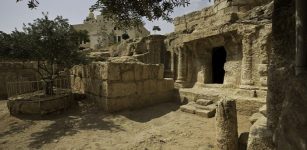 Fascinating Legend Of The Seven Sleepers Of Ephesus
Featured Stories | Oct 31, 2016
Fascinating Legend Of The Seven Sleepers Of Ephesus
Featured Stories | Oct 31, 2016 -
 Enigma Of The Mysterious Ancient Shining Twins – Were They With Humans From The Beginning Of History? Part 1
Ancient Mysteries | Jun 6, 2020
Enigma Of The Mysterious Ancient Shining Twins – Were They With Humans From The Beginning Of History? Part 1
Ancient Mysteries | Jun 6, 2020 -
 Dracula: Cruel, Ruthless And Bloodthirsty Ruler But Not A Vampire
Featured Stories | Sep 12, 2023
Dracula: Cruel, Ruthless And Bloodthirsty Ruler But Not A Vampire
Featured Stories | Sep 12, 2023 -
 Mysterious Stone Of The Sky God: Krishna’s Butter Ball Defies All Laws Of Physics
Featured Stories | Aug 20, 2014
Mysterious Stone Of The Sky God: Krishna’s Butter Ball Defies All Laws Of Physics
Featured Stories | Aug 20, 2014 -
 Search For A Viking Cemetery Near Truso Settlement In Janow, Poland – Continues
Archaeology | Jul 23, 2020
Search For A Viking Cemetery Near Truso Settlement In Janow, Poland – Continues
Archaeology | Jul 23, 2020 -
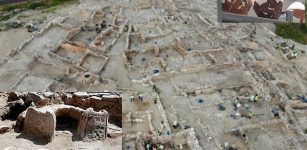 Anatolia’s Seyitömer Mound Was Inhabited In Bronze Age, Achaemenid, Hellenistic, And Roman Times
Archaeology | Aug 17, 2020
Anatolia’s Seyitömer Mound Was Inhabited In Bronze Age, Achaemenid, Hellenistic, And Roman Times
Archaeology | Aug 17, 2020 -
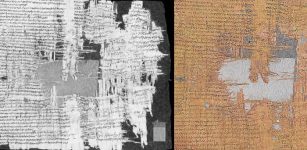 Newly Discovered Papyrus Reveals An Intriguing And Gripping Criminal Case From The Roman Empire
Archaeology | Jan 29, 2025
Newly Discovered Papyrus Reveals An Intriguing And Gripping Criminal Case From The Roman Empire
Archaeology | Jan 29, 2025 -
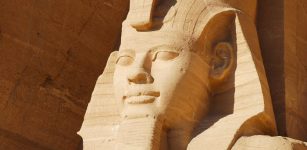 How Ramesses II Became The Greatest Pharaoh In Egypt
Featured Stories | Jun 6, 2021
How Ramesses II Became The Greatest Pharaoh In Egypt
Featured Stories | Jun 6, 2021 -
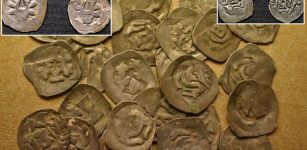 A Hoard Of Silver Coins Found Accidentally Under An Uprooted Tree Near Pieštany, Slovakia
Artifacts | Oct 28, 2020
A Hoard Of Silver Coins Found Accidentally Under An Uprooted Tree Near Pieštany, Slovakia
Artifacts | Oct 28, 2020 -
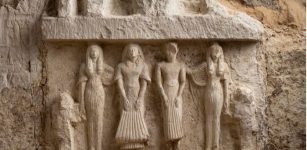 Impressive Ancient Underground Tombs And Chapels Unearthed In Saqqara, Egypt
Archaeology | Apr 16, 2023
Impressive Ancient Underground Tombs And Chapels Unearthed In Saqqara, Egypt
Archaeology | Apr 16, 2023 -
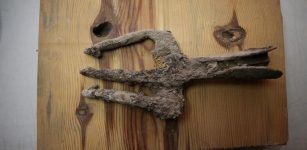 1700-Year-Old Iron Trident Found In The Ancient City Of Assos, Turkey
Archaeology | Nov 1, 2023
1700-Year-Old Iron Trident Found In The Ancient City Of Assos, Turkey
Archaeology | Nov 1, 2023 -
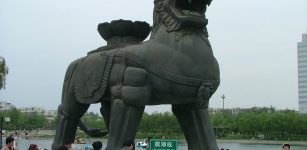 Incredible Ancient Metallurgical Wonders That Defy Explanation And Pose A Real Mystery Even Today
Civilizations | Apr 21, 2014
Incredible Ancient Metallurgical Wonders That Defy Explanation And Pose A Real Mystery Even Today
Civilizations | Apr 21, 2014 -
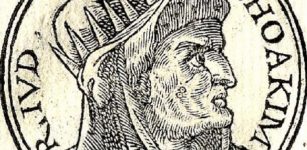 Kingdoms Of Judah And Babylon Remained In Long-Lasting Conflict
Featured Stories | Sep 5, 2019
Kingdoms Of Judah And Babylon Remained In Long-Lasting Conflict
Featured Stories | Sep 5, 2019 -
 DNA In Viking Poop Sheds New Light On 55,000-Year-Old Relationship Between Gut Companions
Archaeology | Sep 5, 2022
DNA In Viking Poop Sheds New Light On 55,000-Year-Old Relationship Between Gut Companions
Archaeology | Sep 5, 2022 -
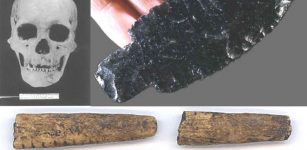 Buhl Woman Of Idaho: One Of The Oldest Skeletons In North America
Civilizations | Jun 3, 2023
Buhl Woman Of Idaho: One Of The Oldest Skeletons In North America
Civilizations | Jun 3, 2023 -
 Unexplained Mystery Of The Untraceable Stone-Throwers – Strangeness In North America, Belgium And Indonesia – Part 1
Featured Stories | Nov 11, 2019
Unexplained Mystery Of The Untraceable Stone-Throwers – Strangeness In North America, Belgium And Indonesia – Part 1
Featured Stories | Nov 11, 2019 -
 On This Day In History: Battle Of Pinkie Was Fought – On September 10, 1547
News | Sep 10, 2016
On This Day In History: Battle Of Pinkie Was Fought – On September 10, 1547
News | Sep 10, 2016 -
 Parthian Jar Burial Dated To 247 BC – 224 CE Unearthed In Iran’s Kurdistan Province
Archaeology | Sep 29, 2020
Parthian Jar Burial Dated To 247 BC – 224 CE Unearthed In Iran’s Kurdistan Province
Archaeology | Sep 29, 2020 -
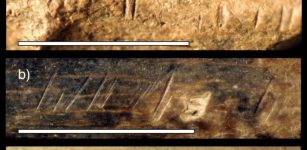 Humans’ Evolutionary Relatives Butchered One Another 1.45 Million Years Ago
Ancient Symbols | Jun 26, 2023
Humans’ Evolutionary Relatives Butchered One Another 1.45 Million Years Ago
Ancient Symbols | Jun 26, 2023

